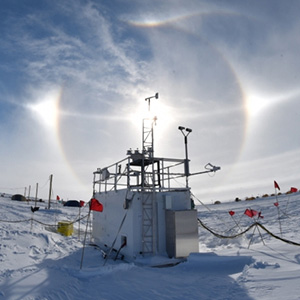|
OPP-Funded Study: Widespread Melt in West Antarctica Documented During Unusually Warm Austral Summer 
National Science Foundation Posted June 15, 2017 Image: Colin Jenkinson, Australian Bureau of Meteorology An area of West Antarctica more than twice the size of California partially melted in 2016 when warm winds forced by an especially strong El Nino blew over the continent, an international group of researchers, supported in part by OPP, has determined. Antarctica is a continent the size of the U.S. and Mexico combined. In the June 15 issue of the journal Nature Communications, the researchers report that the warm spell persisted for more than two weeks in January 2016. Satellite data revealed a mix of melted snow and ice over most of the Ross Ice Shelf--a thick platform of floating ice that channels about a third of the ice flowing from the West Antarctic Ice Sheet into the ocean. While researchers have been gathering evidence for years that warm ocean water is melting West Antarctic ice shelves from beneath, this is one of the first times they've been able to document how warm air could also cause widespread melting from above. As it happens, researchers had installed the necessary instruments to investigate these processes in West Antarctica only a few weeks earlier, as part of a study to better understand how clouds affect the amount of energy that reaches the snow surface and influence its temperature. "We were extraordinarily fortunate to be able to deploy state-of-the art equipment to West Antarctica just before this large melt event occurred," said Dan Lubin, principal investigator of the Atmospheric Radiation Measurement (ARM) West Antarctic Radiation Experiment (AWARE). Lubin is a research physicist at the Scripps Institution of Oceanography in La Jolla, California and a coauthor of the Nature Communications study. ARM / AWARE is supported in part by this collaborative NSF award: https://nsf.gov/awardsearch/showAward?AWD_ID=1443443 Julien Nicolas, lead author of the paper, and a research associate at the Byrd Polar and Climate Research Center (BPCRC) at The Ohio State University is part of the OSU team that provides weather and climate analysis for AWARE. What he saw during the melting event was an area of roughly 300,000 square miles, including most of the Ross Ice Shelf, that likely contained a mix of snow and water. “What probably happened is that the surface snowpack was able to contain the meltwater, acting as a buffer and preventing the formation of melt ponds and streams that can be common on some Antarctic ice shelves,” Nicolas said, “but we cannot rule out the presence of standing water in many locations.” The U.S. Department of Energy also provided funding. Scientists from Brookhaven National Laboratory in New York, Argonne National Laboratory in Illinois, Penn State University, the Australian Bureau of Meteorology and Los Alamos National Laboratory in New Mexico assisted with the study. Read more in news releases issued by OSU: https://news.osu.edu/news/2017/06/15/slushpuddle/ and Scripps: https://scripps.ucsd.edu/news/scientists-report-large-scale-surface-melting-event-antarctica-during-2015-16-el-nino
|
OPP-Funded Study: Widespread Melt in West Antarctica Documented During Unusually Warm Austral Summer



For USAP Participants |
For The Public |
For Researchers and EducatorsContact UsU.S. National Science FoundationOffice of Polar Programs Geosciences Directorate 2415 Eisenhower Avenue, Suite W7100 Alexandria, VA 22314 Sign up for the NSF Office of Polar Programs newsletter and events. Feedback Form |

